BOB GETS THE BEAR
The Rather Extended Hunt for a Lap Steel Home
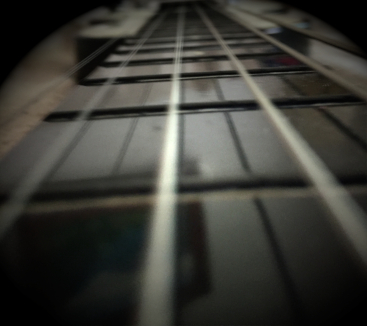
07/08/2020
Telling tales of stalking bears around the campfire is an ancient rite. Truth be told, we of the modern Internet age play out much the same rite that our ancestors did when we tell our stories around the campfires of the guitar forums. The ancients relished telling each other about the one that didn’t get away. The good storytellers managed to shape their tale of the stalking and eventual acquisition of a great bear into a story of triumph that happened despite their own screw-ups and shortcomings. That allowed a glorious tale to be woven with humility, while tamping down over-weaning ego. Pilots' tales are very much akin to this, always telling how the hapless subjects of the stories managed to get their landing gear back on the ground despite their screwups. I’ll be doing the same thing here, telling the story of my fumbling, longtime stalking of a bear. I'll be aided by the fact that the subject of this discussion does indeed carry the name of a bear… and it didn’t get away. Whew. Got through that analogy. And now, the tale.
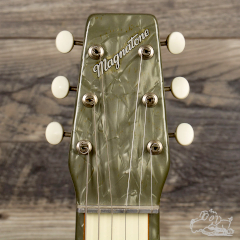
Beginnings
Back in the early 1970s I started playing bottleneck slide with a Coricidin bottle like I had seen Duane Allman use. I played on whatever electric I had at hand, low action, light strings, and all. But after hearing Steve Howe’s work with YES on the album, Close to the Edge, I decided I needed to try a lap steel with its different sound. After saving up my teenage pennies I went shopping. I found a sad, worn-out little 1950s Magnatone steel hanging by a bent tuning peg in the window of a pawn shop. I paid twenty-five dollars to get my start and carried the guitar home in a paper bag on a city bus. I couldn’t afford a tone bar so I packed a long Coricidin bottle full of pennies and sealed it tight with candle wax. I was on my way! There was just one problem: the guitar had horrible hum. After a couple of years of struggling with it I decided to peek under the pickup cover to see if there was a problem. When I carefully unscrewed and lifted the cover, “plink!” the brittle mother-of-toilet seat cover with its fingerboard decal shattered from stem to stern. This was long before the Internet, so that guitar was done.
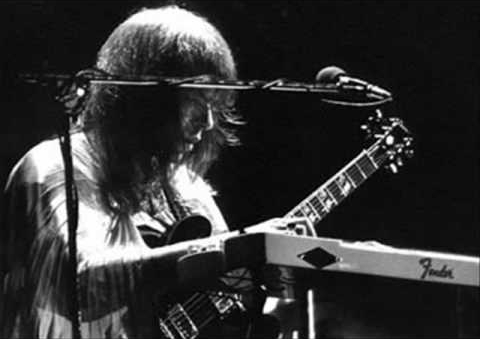
Influences
As mentioned, my first lap steel influence was Steve Howe. Steve has a very bright and Fendery sound and that made sense because he plays Fender Stringmasters and model 1000s. He made heavy use of a volume pedal to round off the attack of his notes. David Gilmour also played a model 1000, a Fender Deluxe 6, and a pair of Jedson Deluxe 6 knockoffs, but his sounds were much rounder than Steve’s. I’ve watched him reach up and roll off high end with the tone control while playing. David had one of his Jedsons modified with an active EMG pickup that rounded out the sound even further. He has also used a ca. 1939 Gibson EH-150 lap steel when he has worked with an acoustic ensemble at Robert Wyatt’s Meltdown Festival in 2001. Best I can tell, he has always built his sound with a little drive and that helped round out the attack as well. Then in 2006 on the On An Island tour, David's multi-instrumentalist, Jon Carin, used an early-50s Rickenbacker BD to echo him and play some of his parts. That guitar sounded quite mellow as well. David Lindley famously played a pair of Rickenbacher (yes, that was the spelling in that period) model Bs in his work with Jackson Browne. At this point he has played one of them almost into the ground. During the classic years he played through a Dumble Overdrive Special amp and his tone was quite driven. David was also known to use a National Dynamic. In the first edition of Wishbone Ash, Ted Turner used an Oahu lap steel that drove his Orange Graphic amps 'til they screamed. And finally, Yves Desrosiers also played a National Dynamic with Sarah Mclachlan around the time of her Surfacing album.

The Chase
Fast forward forty years and two lap steel guitars, a Supro and a Gretsch. In the meantime I heard many, many recordings and saw many performances using lap steels. I began playing my modern Gretsch G5715 on recording sessions around the turn of the century. As with most Fender-esque guitars, I had to back off the high-end to tame the high overtones and attack. As my tastes in guitars matured I began to notice one particular instrument with a different sound... one that had shown up repeatedly on videos and albums providing the sounds that I loved. I began saving for that model several times but never closed in on a particular guitar. It was at this point that another, less expensive guitar model cropped up that looked like it might do. It’s never that simple, is it? My original dream was to track down a Rickenbacher Model B, the guitar that had the sound I loved. After a bunch of research, I figured out which characteristics were important to me and narrowed it down to a favorite: an early wartime “Panda” with black Bakelite body and white panels. Hence the bear reference in the title of this article. Though the wartimes ones aren’t as collectible as their pre-war brethren, they do share the same pickup and thus the signature sound of the pre-war guitars. Interestingly, they add a few improvements that increase the usefulness of the guitar. Only a total of about 3700 pre-war and wartime Ricks were built so the instuments are a bit scarce and costly. The clean ones command a premium price, and I mean really high, as in way out of my intended territory. Enter the second guitar I found: a Gibson EH-150. I’ve heard them used and they can be made to sound very much like the Rick. And therein lay a real problem: A good example of a mid-1930s Gibson EH-150 is also a far sexier looking instrument than a Rick, visually speaking. I mean, a good looking one exudes the epitome of guitar charm. For example, here’s the one I was looking at:
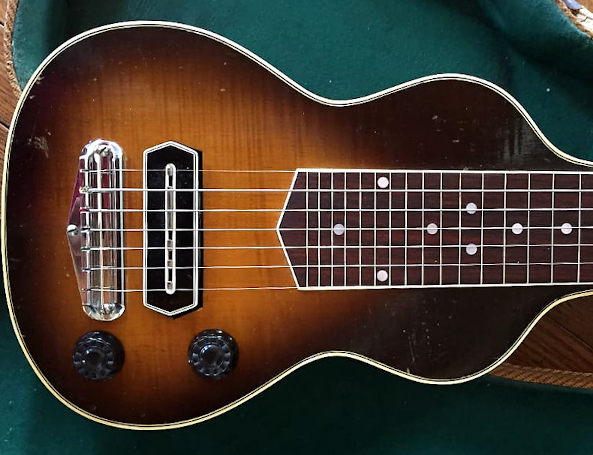
A flame maple top, a sunburst finish that matches my first Les Paul, double-bound body, bound Charlie Christian pickup, bound fretboard, a diamond shaped inlay on the headstock, that thing screams “TAKE ME HOME AND PUT ME ON THE WALL IN A DISPLAY CASE!!!“ Ironically, even a good-looking EH-150 seems to cost quite a bit less than the decent Ricks I’d seen up to that point. I almost bought this one, but before I did I decided to ask around on the forums about the sonic differences between the Rick and the Gibson.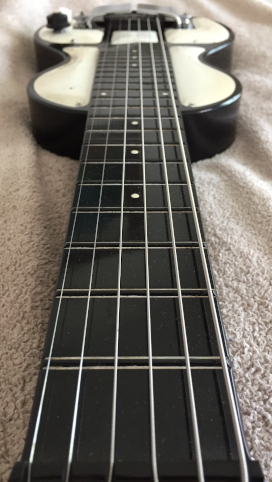 As a result, a more experienced lap steel player quietly got in touch with me via private messaging and we began talking back and forth. He helped me work through my aesthetic dilemma, asking pointed questions that required me to focus on what I was really after – the sound. And that meant pursuing the Rickenbacher. Now, mind you, these early Rickenbachers haven’t been built for over seventy-five years. Examples pop up in vintage stores, on aggregating vintage dealer websites, and on auction sites every so often. Best I can tell, there is no spare parts warehouse out there if something breaks. That means you often have to choose between an intact museum piece, a repaired “player” that has had parts substitutions, or a beater that’s been played into the ground. The museum pieces fetch astronomical prices, so high that you are afraid to use the thing. The players have usually needed repairs, so while they are reliable, they have typically been very well-used before they were repaired and often aren’t very pretty. That creates another dilemma for me because I am an aesthete: I want my guitars to look nice. There. I admitted it. I want a pretty-looking guitar. And all that is left is the third class, the beaters. Besides being aesthetically-challenged, beaters often aren’t reliable, and I needed a reliable guitar.
As a result, a more experienced lap steel player quietly got in touch with me via private messaging and we began talking back and forth. He helped me work through my aesthetic dilemma, asking pointed questions that required me to focus on what I was really after – the sound. And that meant pursuing the Rickenbacher. Now, mind you, these early Rickenbachers haven’t been built for over seventy-five years. Examples pop up in vintage stores, on aggregating vintage dealer websites, and on auction sites every so often. Best I can tell, there is no spare parts warehouse out there if something breaks. That means you often have to choose between an intact museum piece, a repaired “player” that has had parts substitutions, or a beater that’s been played into the ground. The museum pieces fetch astronomical prices, so high that you are afraid to use the thing. The players have usually needed repairs, so while they are reliable, they have typically been very well-used before they were repaired and often aren’t very pretty. That creates another dilemma for me because I am an aesthete: I want my guitars to look nice. There. I admitted it. I want a pretty-looking guitar. And all that is left is the third class, the beaters. Besides being aesthetically-challenged, beaters often aren’t reliable, and I needed a reliable guitar.
Now, regarding reliability, I do see small troves of parts out here, but best I can tell they've been assembled by individuals who have slowly and dilligently scraped together spare parts for years to use on their own guitars. As a result, while digging around for a vintage Rickenbacher guitar I was reminded of the classic Alfa Romeo auto community: Back in the ‘70s and ‘80s when Alfa had abandoned the U.S., my father was a classic Alfa Romeo aficionado. With dealers and primary service gone you could buy a broken-down Alfa for pennies… but you couldn’t find parts. The results were comical: People hoarded parts. We bought a 1963 Giuietta that came with a spare body, three spare engines and transmissions, three sets of trunks, hoods, doors, windshields, mirrors, instrument clusters, steering wheels... you get the idea. If you wanted the car you had to remove the parts from the owner's property. They ended up filling up our basement. For survival, Alfa lovers passed around the names of those who did have various parts. If you needed a part, it came down to developing a relationship with someone who had that part. Typically, members of the community generously helped each other – sometimes from half a continent away. I still have an Alfa shift knob to remind me of the community and of those crazy days.
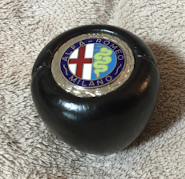
Networking
And so, back to my Rick story, here is where the classic guitar community turned out to be like the classic car community: my new friend Martin took me by the hand and introduced me around to some private individuals in the lap steel community who had Rickenbacher guitars that they wanted to find good homes for. He networked me. I was completely surprised to find that there was another group of guitars out there: nice original or mostly original examples that are in good shape but can be had for reasonable prices… if you plan to play and love them. On my own I would most likely never have discovered a good guitar at an affordable price. In the end it wasn't what I knew, it was whom I was introduced to. One of the fellows Martin introduced me to was Gary, a fellow whose father used to own a small Martin guitar dealership. Years ago Gary’s father had acquired a wartime Model B for himself in trade. When he passed, he left the guitar to his son. It was in really good mechanical and electronic shape and looked nice as well. Gary’s hope was that his father’s guitar would go to someone who would love it. We spent some time talking on the phone, during which Gary gently vetted me. In the end he graciously offered me the guitar.
Model B History
This example is a “generation two” wartime Rickenbacher Model B six string, often called a “B6.” The Model Bs were built from 1934 to 1961 in three “generations” that are typically labeled “Pre-war” (1934-1939), “Wartime” (1940-1944),” and “Post War” (1945 and following). The years don’t quite line up with the dates of America's participation in World War II but that is how they are classified, based upon Rickenbacher’s building practices. There are many specifics to each of the generations, but I’ll just cover a few.
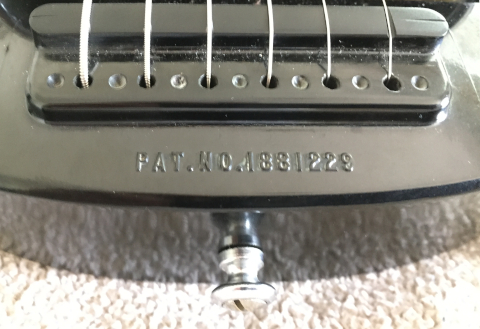
Basically, the first generation Model B introduced “the Rick sound:” a throaty, full, smooth sound that wasn’t very twangy. It had the 1.5” horseshoe magnet pickup with thumbwheels to adjust it and a “Patent Pending” stamp on the pickups ears. The guitar featured a Bakelite body, basically made of bowling ball material, and the model name “B” referred to the Bakelite plastic body. The patent number for the design was stamped into the front of the guitar below the tailpiece. There were chrome-plated steel plates over the body’s cavities. The Model B was fitted with a single volume control with a Bakelite knob on the lower treble side panel. At the tail, the strings passed over a bridge that was cast into the body and then went through the body and anchored at the back. Starting on August 10th, 1937, the very day that Aldolph Rickenbacher received notice that he had been granted a patent for the pickup, the pickups tabs were stamped PAT. NO. 2,089,171. Right after that date they added a tone control opposite the volume control on the player’s side lower panel. In 1939, the tone control moved to the treble side next to the volume control, and the Bakelite knobs were replaced with a less dense plastic. The original guitars had a slight tendency to crack, chip, and pop at the edges of the moldings due to sharp edges and a slightly brittle Bakelite formulation.
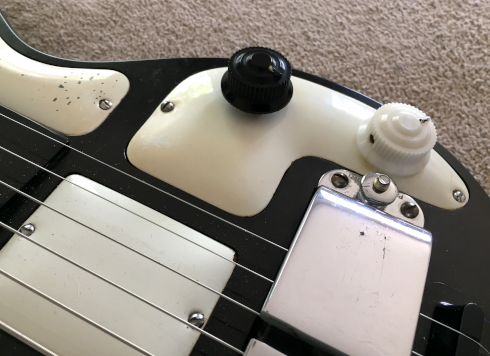
The wartime generation kept the original pickup design with one small change that some say actually improved the sound a little bit: the thickness of the magnets was reduced from 5/32" to 1/8" and a better grade of cobalt steel was used with the result that the new magnets exhibited a greater flux density when charged. They also came up with a refined Bakelite formula that was less inclined to cracking and chipping and the molds were altered to round the edges as well. At the same time the neck’s three reinforcement spars were increased in depth to beef it up with the result that the spars ran in a straight line from the neck/body joint right up into the headstock. Due to wartime shortages, the early wartime guitars featured white enameled steel body panels rather than chromed ones, earning the guitar the “Panda” nickname. Soon after America entered the war, the steel body plates were replaced with white celluloid ones to save steel. These have proven prone to breakage over time. The output jack also migrated from the player’s side to the audience’s side. This design was built through 1944 and serial number C3700.

The thicker, second generation neck
Starting in 1945, the postwar generation brought in major changes. The pickup was replaced entirely, yielding a different sound. It was surrounded with a chromed housing with Phillips screws. The tailpiece was a steel plate that hovered over the top and the bridge became a separate piece that was screwed on, and those changes also altered the sound. They returned to the white-painted steel plates. The logo plate was changed to a large T-shape, the spelling of the company name eventually changed to “Rickenbacker” with a “k” after WWI pilot Eddie Rickenbacker changed his spelling, and they stopped stamping a serial number into the guitars. Around 1949 they added an upgrade version called the "BD" that featured a steel, hinged plate over the headstock. There’s debate over whether these postwar guitars sound as good as the previous generations but all the examples I’ve heard on recordings have sounded fine.
On the Truck
Back to my story, Gary packed up the guitar extremely carefully with bubble wrap all around it inside the case, padding under the headstock, luan sheets on each side of the case, padding outside of the luan, a custom box built out of heavy cardboard, and packing tape on the outside to bind it all together, and sent it off to me. It arrived the next day. As I unpacked the box, I shot pics for this page. The box weighed twenty-one pounds! This guitar is a heavy, substantial instrument. My Supro, by contrast, is a flyweight.
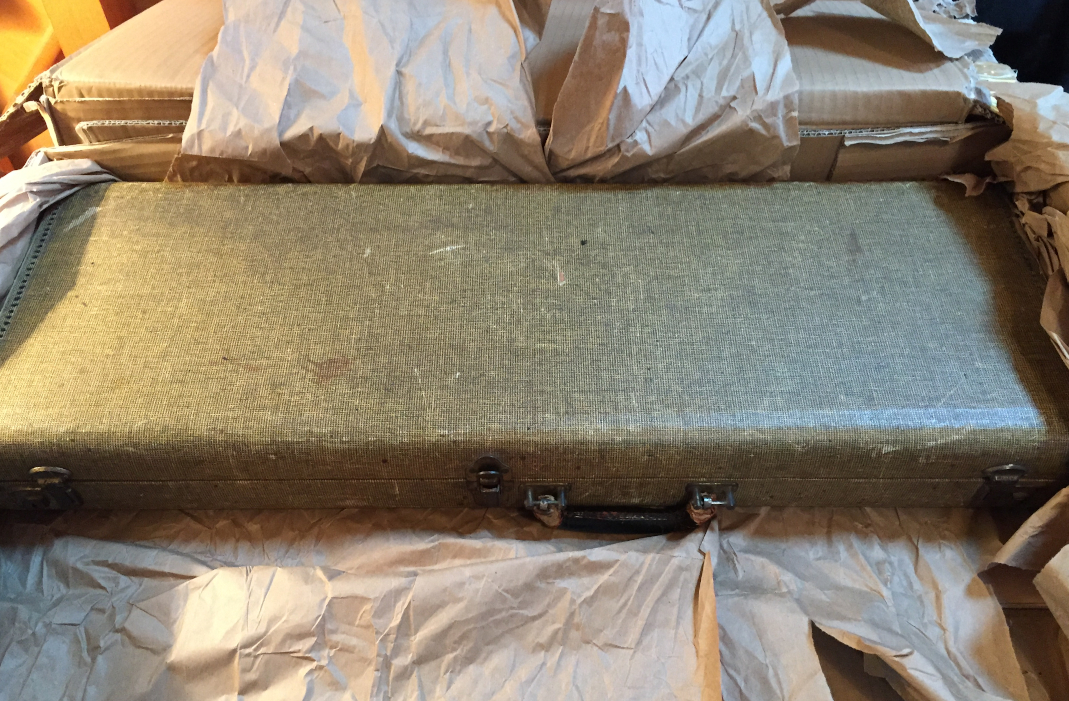
More Pics HERE.
The Sound
Once I got the guitar unpacked I plugged it into a nearby Fender Custom ’68 Princeton Reverb amp to check it out. It immediatly gave forth that wonderful, smooth clean sound it is known for. The next amp I tried was a 1960s Gretsch 6150T which broke up much earlier and gave it a really swampy, bluesy sound. Through a modeled Deluxe Reverb it can go from clean and clear to quite rocky. I have since played it through various amps and tried it on various songs. The tonal results of the heavy, dense body are pretty much what I would expect: it has a gentle, smooth attack and a strong and long sustain phase with plenty of midrange. The sound is much closer to that of a pedal steel than many of the lap steels I’ve tried, and that was what I was hoping for. It is throatier and less twangy than most as well - I don't find myself backing off the tone control. The upper-mids are quite moderate but there is enough high-end to allow attack definition as needed, an effect sort of like the effect of a cedar top on an acoustic guitar. Marvelous. It can produce a country sound when played through a bright, clean Fender amp and can scream through a darker amp that is driven. Interestingly though, it doesn’t seem to need that much drive to sing and sustain. It can do most of the David Gilmour sounds with medium drive and with the tone control wide open.
It immediatly gave forth that wonderful, smooth clean sound it is known for. The next amp I tried was a 1960s Gretsch 6150T which broke up much earlier and gave it a really swampy, bluesy sound. Through a modeled Deluxe Reverb it can go from clean and clear to quite rocky. I have since played it through various amps and tried it on various songs. The tonal results of the heavy, dense body are pretty much what I would expect: it has a gentle, smooth attack and a strong and long sustain phase with plenty of midrange. The sound is much closer to that of a pedal steel than many of the lap steels I’ve tried, and that was what I was hoping for. It is throatier and less twangy than most as well - I don't find myself backing off the tone control. The upper-mids are quite moderate but there is enough high-end to allow attack definition as needed, an effect sort of like the effect of a cedar top on an acoustic guitar. Marvelous. It can produce a country sound when played through a bright, clean Fender amp and can scream through a darker amp that is driven. Interestingly though, it doesn’t seem to need that much drive to sing and sustain. It can do most of the David Gilmour sounds with medium drive and with the tone control wide open.
“Getting to know you”
For years I have maintained that spending time cleaning up a guitar that is new to you is the best way to learn about it, and this guitar was no exception. The next day I tried out ways to clean up the Rick without damaging it. Eventually I settled in with a bowl of water, Q-Tips, and a good concert video and spent a couple of hours gently cleaning out the fung, gradoo, and schmutz from the recessed white fret marker lines on each side of the molded frets. I also used a gentle automobile polish to polished the old girl. I came away with about twenty to thirty dirty brown Q-Tips, a couple of really dirty rags, and a gleaming, smiling guitar. I was impressed at how stout the guitar’s Bakelite finish is. It is always amazing to see what a little love can do for an old instrument. With the time I spent on cleanup and polishing I did, indeed, learn much about the guitar’s design and construction. But I learned far more - I came to know something of the previous owners' playing styles. I could tell where along the length of the string that they had picked by the nicks in the finish of the far-side steel plates, left by their metal fingerpicks. I could also tell where they had gently braced the heels of their right hands for stability by the fine patina they left on the enamel of the near-side panels. I got a real feel for the history of the instrument from those clues.
One interesting anomaly on this guitar is that Rickenbacher left off the "G" third position markers, making it easier to get lost on the fretboard. I'm probably going to find some adhesive dots to place in those positions to keep myself in line. The former owner of one Rick I was looking at had solved this problem by adding little squares of gaff tape.
This Particular Example:
Spotting characteristics:
Strings through body tailpiece (pre-1945)
Integrated bridge (pre-1945)
Rounded body edges (starting 1940)
Steel panels with white enamel (starting 1940)
Jack on audience side (starting 1940)
Second neck profile with thicker spars straight from heel to nut (starting 1940)
Molded frets with white outlines and white painted position markers (starting 1940)
1.5” horseshoe pickup (pre-1945)
PAT. NO. 2,089,171 pickup tabs (starting 08/10/37)
Tone and volume controls on treble side stacked vertically with “flying saucer” knobs (starting 1939)
Black and white plastic volume and tone knobs (ca. 1939-1941)
Individual tuning machines with seven-sided cast metal keys (ca. 1939-1941)
Horizontal, small logo plate with “Rickenbacher” spelling (pre-1945)
Serial number in the 3400 range.
Being a student of WWII, the significance of the general dating of this guitar to around 1939-42 is not lost on me. For example, that span encompasses Dunkirk, the Battle of Britain, Pearl Harbor, and the Battle of Midway.
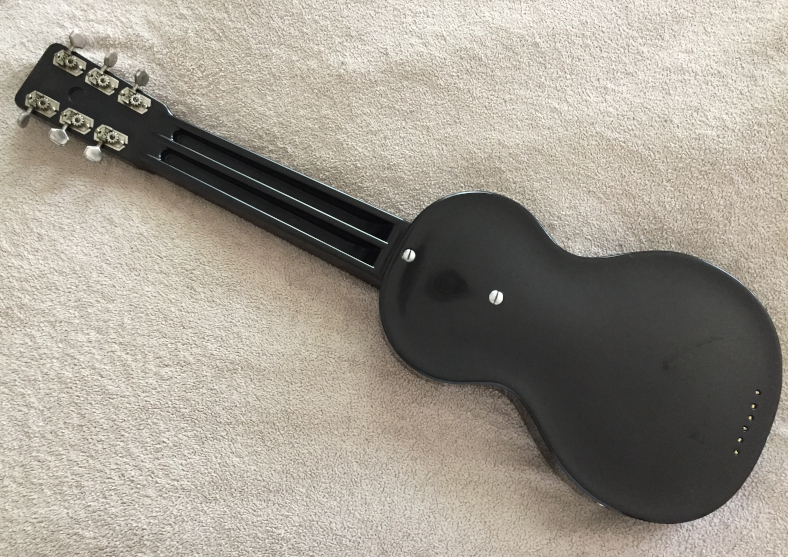
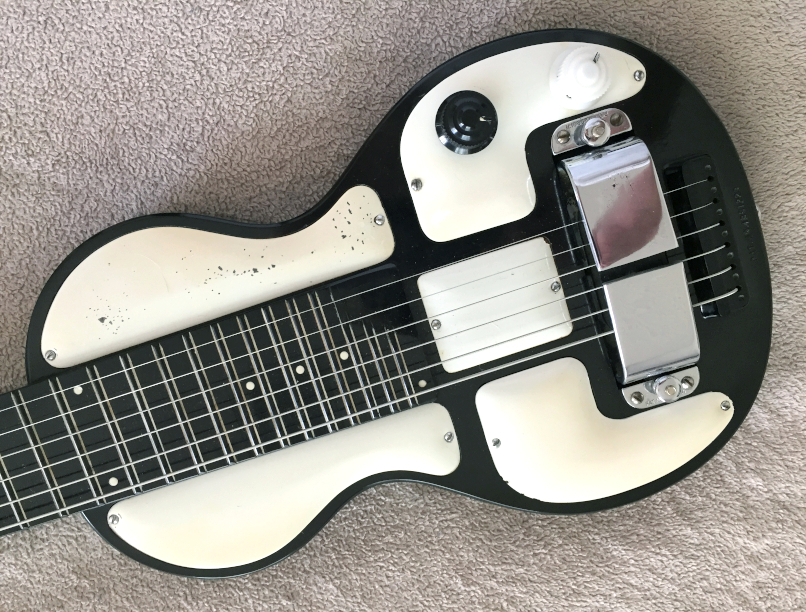
So, having spent time with the guitar and having given it time to settle in, I turn to Captain Jack Sparrow and a quote from Pirates of the Caribbean:
"I think we've all arrived a very special place - spiritually, ecumenically, grammatically."
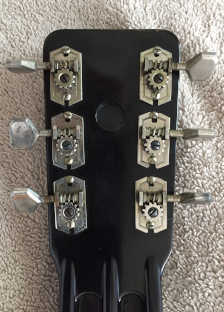
More pictures, HERE.
UPDATE 08/02/2020
It is a little-known fact that the Rickenbacher B is missing some position markers on the fingerboard. The third and thirteenth fret "G" position markers weren't included in the design. I've seen some pros have approach the problem by putting on gaff tape markers. It can get kind of rustic.
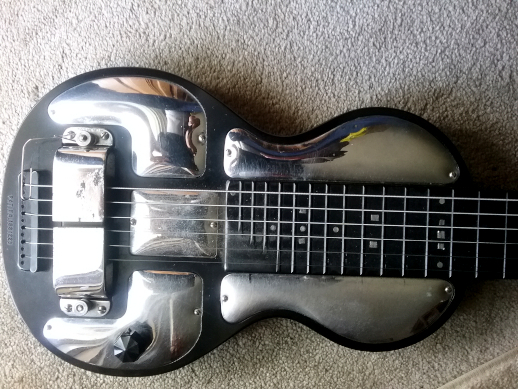
Here's a pretty well-known player's hack.
Note the novel paperclip grounding scheme as well.*
I found myself a little thrown off by their absence as well. I know, I know, it's a first world problem. However, a solution popped up on a forum a short while ago and I availed myself of it. Rosette Guitar Products offers dry-transfer marker dots for guitar. I measured the Rick dots and found them to be 1/8" in diameter. Rosette offers a 1/8" in ivory color surrounded by a black ring. I ordered a pack of them and received them promptly in first class mail with a personal greeting from the owner included. The dry transfer was easy.
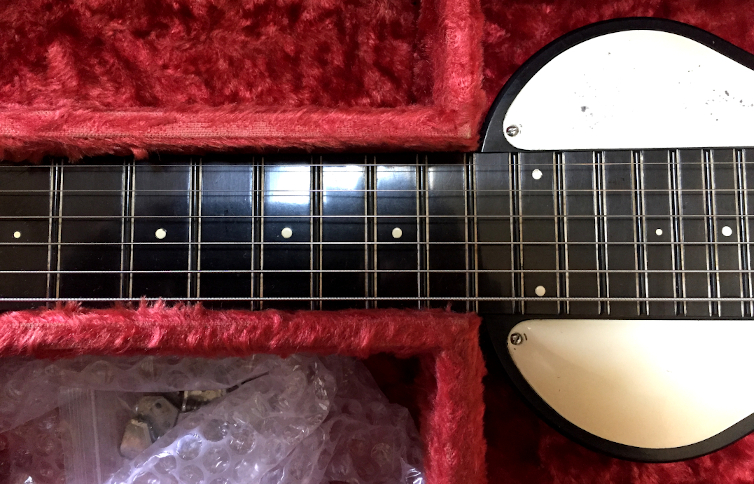
A nice near-match
I accidently put pressure on a second dot and it transferred, so I got the opportunity to take off one as well. As suggested by the instructions, the errant dot was easily removed by lightly scraping with my fingernail, leaving no mark or trace. As you can see above, the dot's ivory color nicely matched the 80-year-old color of the Rick's dots, though the new dot's black rings made them appear a tad smaller. Et Voile'! I'm well-oriented now on the fretboard and that was well-worth the entry price! We'll see how they hold up, but there's no reason to be concerned for their longevity because I don't touch the fingerboard when I play.
* The early Model Bs seemed to have an issue with string grounding. This fix shows some ingenuity. The owner grounded one string. Up at the other end of the string the nut is steel, so the rest of the strings make contact and benefit from the one that is grounded. I tried this out on mine and it didn't seem to need the addition.

= =
=






 As a result, a more experienced lap steel player quietly got in touch with me via private messaging and we began talking back and forth. He helped me work through my aesthetic dilemma, asking pointed questions that required me to focus on what I was really after – the sound. And that meant pursuing the Rickenbacher. Now, mind you, these early Rickenbachers haven’t been built for over seventy-five years. Examples pop up in vintage stores, on aggregating vintage dealer websites, and on auction sites every so often. Best I can tell, there is no spare parts warehouse out there if something breaks. That means you often have to choose between an intact museum piece, a repaired “player” that has had parts substitutions, or a beater that’s been played into the ground. The museum pieces fetch astronomical prices, so high that you are afraid to use the thing. The players have usually needed repairs, so while they are reliable, they have typically been very well-used before they were repaired and often aren’t very pretty. That creates another dilemma for me because I am an aesthete: I want my guitars to look nice. There. I admitted it. I want a pretty-looking guitar. And all that is left is the third class, the beaters. Besides being aesthetically-challenged, beaters often aren’t reliable, and I needed a reliable guitar.
As a result, a more experienced lap steel player quietly got in touch with me via private messaging and we began talking back and forth. He helped me work through my aesthetic dilemma, asking pointed questions that required me to focus on what I was really after – the sound. And that meant pursuing the Rickenbacher. Now, mind you, these early Rickenbachers haven’t been built for over seventy-five years. Examples pop up in vintage stores, on aggregating vintage dealer websites, and on auction sites every so often. Best I can tell, there is no spare parts warehouse out there if something breaks. That means you often have to choose between an intact museum piece, a repaired “player” that has had parts substitutions, or a beater that’s been played into the ground. The museum pieces fetch astronomical prices, so high that you are afraid to use the thing. The players have usually needed repairs, so while they are reliable, they have typically been very well-used before they were repaired and often aren’t very pretty. That creates another dilemma for me because I am an aesthete: I want my guitars to look nice. There. I admitted it. I want a pretty-looking guitar. And all that is left is the third class, the beaters. Besides being aesthetically-challenged, beaters often aren’t reliable, and I needed a reliable guitar.




 It immediatly gave forth that wonderful, smooth clean sound it is known for. The next amp I tried was a 1960s Gretsch 6150T which broke up much earlier and gave it a really swampy, bluesy sound. Through a modeled Deluxe Reverb it can go from clean and clear to quite rocky. I have since played it through various amps and tried it on various songs. The tonal results of the heavy, dense body are pretty much what I would expect: it has a gentle, smooth attack and a strong and long sustain phase with plenty of midrange. The sound is much closer to that of a pedal steel than many of the lap steels I’ve tried, and that was what I was hoping for. It is throatier and less twangy than most as well - I don't find myself backing off the tone control. The upper-mids are quite moderate but there is enough high-end to allow attack definition as needed, an effect sort of like the effect of a cedar top on an acoustic guitar. Marvelous. It can produce a country sound when played through a bright, clean Fender amp and can scream through a darker amp that is driven. Interestingly though, it doesn’t seem to need that much drive to sing and sustain. It can do most of the David Gilmour sounds with medium drive and with the tone control wide open.
It immediatly gave forth that wonderful, smooth clean sound it is known for. The next amp I tried was a 1960s Gretsch 6150T which broke up much earlier and gave it a really swampy, bluesy sound. Through a modeled Deluxe Reverb it can go from clean and clear to quite rocky. I have since played it through various amps and tried it on various songs. The tonal results of the heavy, dense body are pretty much what I would expect: it has a gentle, smooth attack and a strong and long sustain phase with plenty of midrange. The sound is much closer to that of a pedal steel than many of the lap steels I’ve tried, and that was what I was hoping for. It is throatier and less twangy than most as well - I don't find myself backing off the tone control. The upper-mids are quite moderate but there is enough high-end to allow attack definition as needed, an effect sort of like the effect of a cedar top on an acoustic guitar. Marvelous. It can produce a country sound when played through a bright, clean Fender amp and can scream through a darker amp that is driven. Interestingly though, it doesn’t seem to need that much drive to sing and sustain. It can do most of the David Gilmour sounds with medium drive and with the tone control wide open.




